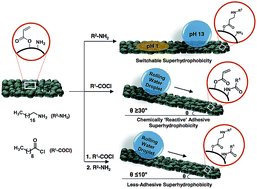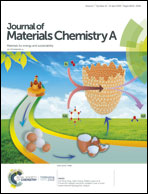A biodegradable polymer-based common chemical avenue for optimizing switchable, chemically reactive and tunable adhesive superhydrophobicity†
Abstract
The development of different extreme water wettability properties, including tunable adhesion and stimuli-responsive superhydrophobicity, has emerged as an important avenue with enormous prospects for diverse applications, addressing real-life problems. Various approaches and designs have been adopted for optimizing these different super-water-wettability properties separately. In this current report, a common and robust chemical approach is introduced for creating chemically reactive, tunable adhesion and stimuli-responsive superhydrophobicity, where a chitosan-based covalently cross-linked material with dual chemically reactive functionality is synthesized following a facile 1,4-conjugate addition reaction between amine and acrylate groups. The synthesized polymeric material, which was loaded with residual acrylate and primary amine groups, provided a facile basis for both single and dual post-functionalization with a wide range of chemical moieties through the rational use of Michael addition reactions and nucleophilic substitution processes. Depending on the selection of appropriate post-chemical functionalization, chemically reactive, tunable adhesion and pH-responsive switchable superhydrophobicity was optimized. The embedded pH-responsive superhydrophobicity was extended further to develop self-cleaning prints; examples of such materials are rare in the literature. Such materials would be of utmost importance for various potential applications, including patterned wettability, smart microfluidic devices, customized drug delivery systems, etc. Moreover, the naturally abundant and biodegradable polymer-based less-adhesive superhydrophobicity was capable of withstanding various types of chemical and physical exposure without any significant alteration in the embedded extreme water wettability. Designing such simple and single synthetic method for developing various (tunable adhesion and stimuli-responsive) super-water repellent interfaces, using naturally abundant and biodegradable raw materials, is challenging and is important for various prospective applications in diverse and extreme settings.



 Please wait while we load your content...
Please wait while we load your content...